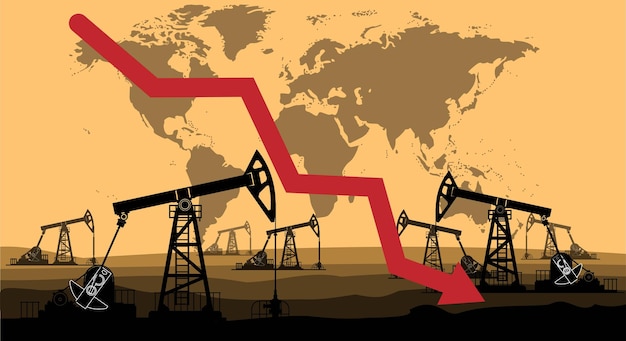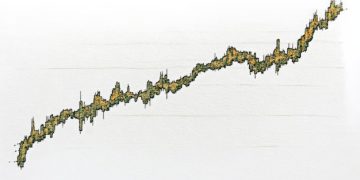Commodities Investing: Your Guide to Trading Raw Materials

Investing in commodities involves trading raw materials like oil, gold, and agricultural products, offering diversification and potential inflation hedging, but it also entails significant risks due to market volatility and external factors.
Are you curious about investing in commodities: a guide to trading raw materials? Commodities offer investors unique opportunities to diversify portfolios and potentially profit from global economic trends, but understanding the markets and risks involved is crucial for success.
Understanding Commodities Investing
Commodities investing refers to the practice of allocating capital to raw materials or primary agricultural products. These materials are the building blocks of the global economy and, as such, their prices can be influenced by a variety of factors including supply and demand, geopolitical events, and even weather patterns.
What Are Commodities?
Commodities fall into several broad categories, including:
- Energy: Crude oil, natural gas, gasoline
- Metals: Gold, silver, copper, platinum
- Agriculture: Corn, soybeans, wheat, sugar
- Livestock: Live cattle, lean hogs
Each of these commodities has its own unique set of market dynamics influenced by production, consumption, and global events.
Why Invest in Commodities?
Investors may consider commodities for several reasons:
- Diversification: Commodities often have a low or negative correlation with traditional asset classes like stocks and bonds, providing portfolio diversification.
- Inflation Hedge: Commodities can act as a hedge against inflation because their prices tend to rise along with inflation.
- Profit Potential: Changes in supply and demand can create opportunities for profit.
Ultimately, commodities provide exposure to the fundamental resources that underpin economic activity, creating trading possibilities that aren’t linked to the stock market.
Direct vs. Indirect Commodity Investing
There are several ways to invest in commodities, each with its own advantages and disadvantages. Some are direct, while others provide more indirect exposure.
Direct Investment Options
- Commodity Futures: These are contracts to buy or sell a specific quantity of a commodity at a future date. These are often used by producers to hedge their production and by speculators to profit from price movements.
- Physical Commodities: This means buying and storing physical commodities like gold bars or barrels of oil, which can be difficult and costly due to storage and insurance expenses.
Indirect Investment Options
- Commodity ETFs: These exchange-traded funds invest in commodity futures contracts, giving investors exposure to a basket of commodities without the need to buy or store the physical goods.
- Commodity Stocks: Investing in companies that produce or process commodities, such as oil companies, miners, or agricultural firms. The advantage here is that investors can research and pick companies they think will succeed.

Choosing between direct and indirect investing depends on your risk tolerance, trading expertise, and capital available. Direct investing can offer greater profit potential but also carries a higher risk.
Commodity Trading Strategies
Effective commodities trading requires a well-defined strategy based on research, market analysis, and risk management. Several strategies can be employed, depending on the投资者’s objectives and risk appetite.
To start, let’s talk about understanding market trends:
- Trend Following: Identifying and trading in the direction of prevailing price trends.
- Mean Reversion: Capitalizing on the tendency of prices to revert to their average value.
Another key element is the analysis of supply and demand factors:
- Supply Disruptions: Taking advantage of unexpected events that impact supply, such as weather-related crop failures or geopolitical instability affecting oil production.
- Demand Shifts: Trading based on changing demand patterns due to factors like economic growth or technological advancements.
In order to protect your investments you should implement hedging strategies:
- Hedging: Offsetting potential losses in one investment with a corresponding investment in a related asset. Example: airlines use this to protect themselves against fuel price increases.
Understanding Market Influences
Commodity prices are influenced by a multitude of factors that traders must understand to make informed investment decisions. These can be broadly categorized into supply-side factors, demand-side factors, and other external influences.
- Geopolitical Risk: Political instability in regions that produce or transport commodities can disrupt supply chains and drive up prices. Sanctions, trade disputes, and military conflicts are all potential catalysts.
Environmental factors can also significantly disrupt commodity markets:
- Weather Patterns: Extreme weather events can devastate agricultural production, leading to supply shortages and price spikes. Droughts, floods, and frosts are common culprits.

Lastly, government policies can play a role.
- Government Policies: Government regulations, tariffs, and subsidies can influence commodity prices by altering supply and demand dynamics.
The combined interplay of supply, demand, and external factors determines the price volatility and potential profitability of commodities.
Risk Management in Commodity Trading
Commodity trading can be highly speculative and volatile, so effective risk management is essential for success and capital preservation. Here are some risk management techniques:
- Stop-Loss Orders: These automatically close out a position if the price moves against you, limiting potential losses.
- Position Sizing: Limiting the amount of capital allocated to a single trade, thus reducing the overall impact of any one trade on your portfolio.
- Diversification: Spreading investments across a range of commodities to reduce exposure to any one particular market.
Another item to consider would be the importance of market knowledge and the use of trading resources
- Market Knowledge: Staying informed about market trends, supply and demand factors, and geopolitical events.
- Trading Resources: Utilizing trading platforms, analytical tools, and educational resources to enhance trading knowledge and decision-making skills.
All of these steps can help to better manage risk, so that rewards are much more likely!
Building a Balanced Commodity Portfolio
A well-diversified commodity portfolio can provide a valuable hedge against inflation and economic uncertainty while offering the potential for returns. The construction of such a portfolio requires careful consideration of several factors, including risk tolerance, investment objectives, and market outlook.
Commodity Allocation
Diversification is key when building a well-rounded portfolio.
- Asset Allocation: Determining the appropriate percentage of your portfolio to allocate to different commodity sectors, such as energy, metals, and agriculture.
- Commodity Selection: Choosing specific commodities within each sector based on their individual risk-return profiles and potential for growth.
Continuous Portfolio Assessment
You can’t just make a portfolio and let it ride, you need to make sure it is still in line with the realities of the market.
- Regular Review: Continual portfolio evaluation to ensure that the asset allocations and commodity selections remain aligned with your investment objectives and risk tolerance.
- Make Adjustments Appropriately: As market conditions change, rebalance the portfolio to maintain diversification and manage risk.
The key to a successful commodity portfolio is to constantly check in on it and change as need be.
| Key Point | Brief Description |
|---|---|
| 💡 Diversification | Commodities offer low correlation with stocks, enhancing portfolio diversity. |
| 🛡️ Inflation Hedge | Commodity prices often rise with inflation, protecting purchasing power. |
| 📊 Market Factors | Supply disruptions and demand shifts drive commodity price fluctuations. |
| ⚠️ Risk Management | Implement strategies like stop-loss orders to limit potential losses. |
Frequently Asked Questions
▼
The main types of commodities are energy (crude oil, natural gas), metals (gold, silver, copper), agriculture (corn, soybeans, wheat), and livestock (live cattle, lean hogs).
▼
You can invest indirectly through commodity ETFs (exchange-traded funds) or by purchasing stocks of companies that produce or process commodities, such as mining or agriculture firms.
▼
Commodity prices depend on factors such as supply disruptions, changing demand patterns (economic growth), geopolitical events, and governmental regulations such as sanctions and tariffs.
▼
Stop-loss orders, position sizing, diversification across multiple commodities, and hedging strategies are all valuable for limiting potential losses.
▼
It’s important to regularly review and rebalance your portfolio as market conditions change, typically quarterly or annually, to maintain diversification for continued asset allocation.
Conclusion
Trading commodities can be a complex world, but hopefully, this guide has helped you to learn the basics, like that investing in commodities: a guide to trading raw materials is a way of diversifying a portfolio to hedge against inflation, but also has great risk depending on market volatility and global conditions that are often hard to predict.





